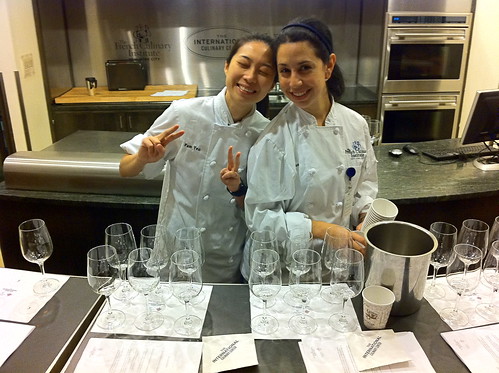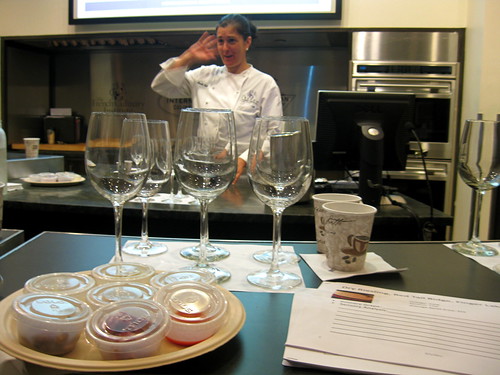My friend Pam and I setting up for wine day.
(Picture courtesy of my friend Anna)
Many people ask me how big a component wine is in the program. The answer is (sadly) "just one day," but it was one of my favorites. Despite being only a single day, the seminar was pretty comprehensive and banged out the basics of wine, tasting, and pairing. The one slight bummer was that we actually weren’t allowed to drink the wine; we had to spit. I suppose it wouldn’t do to have a bunch of drunk students roaming around the school, but it still seemed like such a waste to toss all of that lovely wine.
I love wine tasting. It is one of my favorite games to pick out all of the different flavors. I also think it’s interesting to track how your palate changes over time. In the beginning maybe you only taste red and white –or maybe room temp and cold. This period might also coincide with a budget that only allows you to drink what amounts to alcoholic grape juice. Possibly your wine is coming out of a jug. Maybe your wallet occasionally forces you to revisit this stage. Then one day you try something a little better and there’s more there. Suddenly there are berries in your glass or citrus. You keep tasting and over time the number of things you get out of one sip multiplies exponentially. You start to pick out specific berries and citrus, then there are apples, honeyed pineapple, chocolate, vanilla, caramel, pepper, smoke, tobacco—any number of sensations in one glass. It takes practice though, and the more widely you taste, the more you’ll be able to pick out. I have to say I’m pretty happy with where I am now. I can appreciate a good wine when it’s served to me, but I’m absolutely ok with table wine with weeknight dinners.
The next step in the evolution is wine pairing. There comes a day when maybe you’re sitting enjoying a big, intense red just as you always have. Then your fish dinner arrives at the table and you start to eat. When you go back to that red you liked so much, it tastes like someone poured chalk in it. It’s time to start putting thought into your wine and food pairings.
One of the first times this really clicked for me was during a lunch one day at Campanille in Los Angles years ago. I asked for help from the sommelier to choose a wine to go with the fish and chips I’d ordered. He recommended a minerally white, which would have been far from my first choice at the time, but I took his suggestion. When I tried the wine and fish together my mouth went “Oh! This is what they’re talking about.” The wine and food both got better. It was absolutely a Eureka moment.
Since then wine and food became two sides of the same coin and pairing them fascinates me. It is something I really want to learn more about. This is also where Wine Day was the most intriguing for me. The pairing component the Chef put together was really fun and interesting. Since it would be inconvenient –even in a culinary school—to put together a feast encompassing all of the flavors we regularly eat, we were all given a plate with various different cups containing salt, butter, lemon, sriracha, sugar, smoke almonds, and salami. Chef instructed us to combine these in different ways, essentially mimicking the elements of a meal to see how they paired with wines is good and bad ways. For example, the smoked almond, dipped in a little butter, with lemon, salt, sugar, and sriracha became “Pad Thai.” When we tried the Pad Thai with most of the wines they either fell flat or turned bitter, however, when sampled with a Riesling the complex flavors in the wine were brought out and the sharp edges on the flavors of both the food and the wine were rounded off. In this way we sampled a whole menu of pairings.
This experiment would be very easy to recreate at home. Grab a few bottles and play around with mixing and matching them with the different flavors to see what works. Start off simply by combining one or two elements and build up to create a “dish.
The very basics of pairing are that you either want to compare or contrast flavors, but it is generally easier to compare than contrast. If you pick out a flavor in a wine, chances are it will pair well with foods containing that flavor. Another factor to keep in mind is that Old World Wines (from Europe) are generally more earthy in character, are higher in acidity, are more subtle, and tend to pair well with foods. New World Wines (from U.S., Australia, South Africa, South America, and New Zealand) tend to have bolder, more intense flavors, and tend to be more fruit forward. They also tend to be more full bodied and have higher alcohol contents than the Old World style wines.
Our tasting day focused on seven varietals. We sampled examples each of the Big Six varietals, which are the most common types: Sauvignon Blanc, Chardonnay, Riesling, Pinot Noir, Merlot, and Carnet Sauvignon. On top of that we also tried a Syrah, since it has been gaining in popularity. Here is the full tasting list – the average retails price of everything on the list is $25 or below:
- Red Tail Ridge Dry Riesling, 2008, Finger Lakes, NY (Regular readers might recognize that name from our visit to the Finger Lakes)
- Alfred Merkelbach Ürziger Würzgarten Riesling Spätlese, 2008, Mosel, Germany
- Fournier Pere et Fils Sancerre Blanc les Belles Vignes (Sauvignon Blanc), Loire Valley, France
- Babich Family Estates Winemakers Reserve Sauvignon Blanc, 2009, Marlborough, New Zealand
- Trevor Jones Virgin Chardonnay, 2008, Australia
- MatchBook Old Head Chardonnay, 2009, Dunnigan Hills, California
- Route Stock Cellars 99W Pinot Noir, 2009, Willamette Valley, Oregon
- Wines of Substance Merlot, 2008, Walla Walla, Washington
- Goyette Cabernet Sauvignon, 2007, Nappa Valley, California
- Domaine Philippe et Vincent Jaboulet Crozes-Hermitage Nouvelere (Syrah), Rhone, France, 2006
Tasting experiment:
Pairings obviously don’t end with wine. You can pair any beverage with foods. Chef suggested that one really good pairing is Snickers bars with Coke, the idea being that the carbonation and sweetness of the coke bring out the saltiness of peanuts, and it’s all supposed to play together really well.
My friend Anna and I played with this combo yesterday. We were really excited to try it, but sadly this pairing didn’t really work for either of. Maybe we had overly high expectations, because at least for me, the combo totally worked in my head. Give it a try and let me know how it works for you.
Or if you have other favorite pairings and wine Eureka moments, I’d love to hear about those as well.














No comments:
Post a Comment